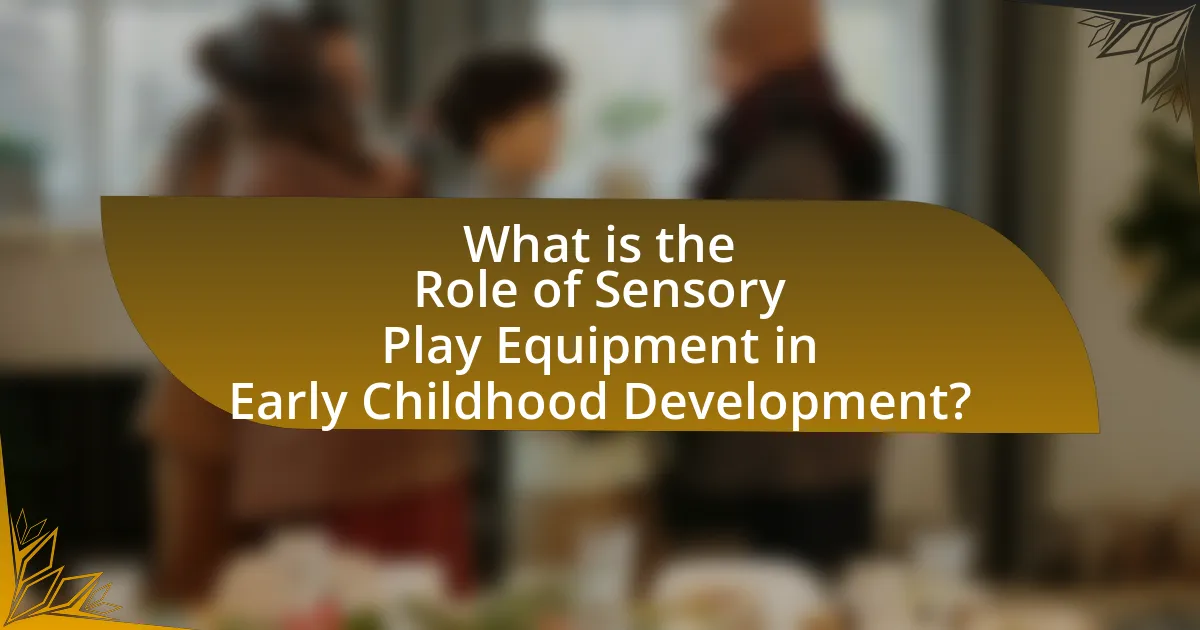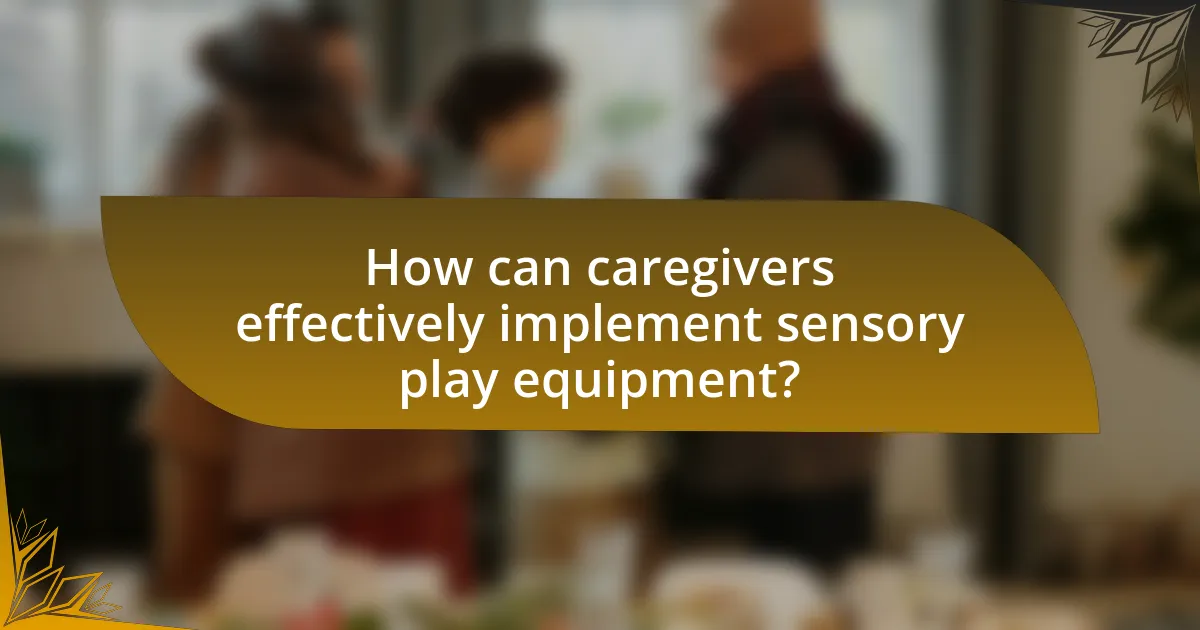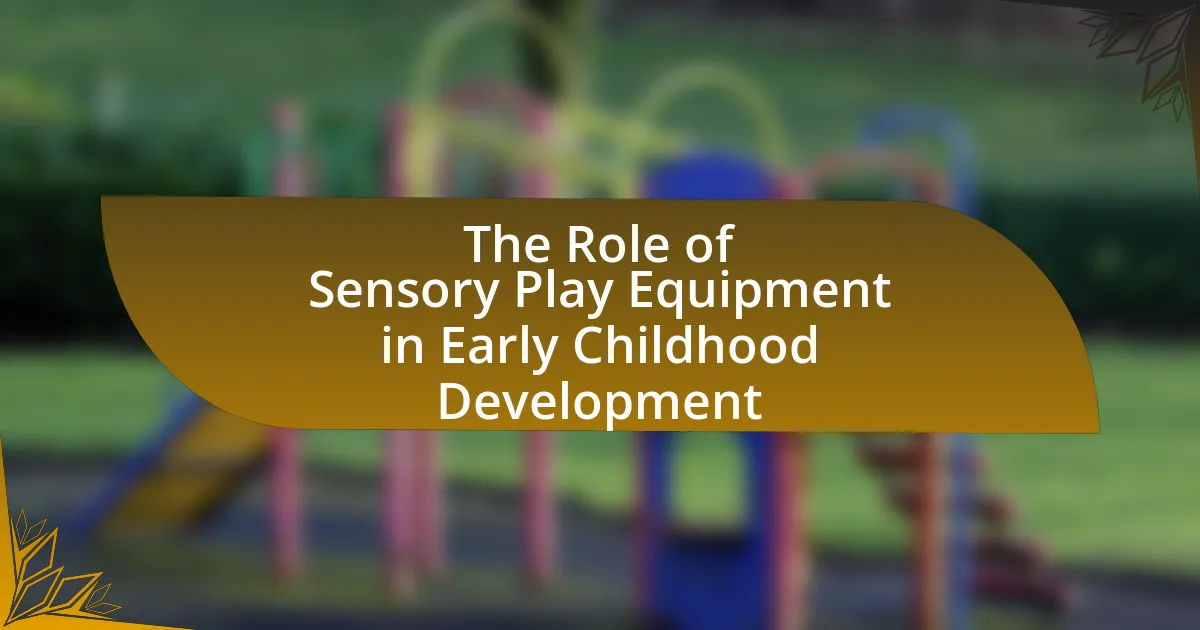Sensory play equipment is essential for early childhood development, significantly enhancing children’s cognitive, social, and emotional growth through engagement with their five senses. This article explores how sensory play contributes to the development of fine and gross motor skills, language abilities, and problem-solving skills, supported by research findings. It also discusses various types of sensory play equipment, such as sensory bins and water play stations, and their impact on learning and emotional regulation. Additionally, the article highlights best practices for caregivers in implementing sensory play, addressing safety considerations, and encouraging exploration and creativity in children.

What is the Role of Sensory Play Equipment in Early Childhood Development?
Sensory play equipment plays a crucial role in early childhood development by enhancing children’s sensory experiences, which are vital for cognitive, social, and emotional growth. Engaging with sensory play equipment stimulates the five senses—sight, sound, touch, taste, and smell—allowing children to explore and understand their environment. Research indicates that sensory play can improve fine motor skills, language development, and problem-solving abilities. For instance, a study published in the journal “Early Childhood Research Quarterly” found that children who participated in sensory play showed significant improvements in their ability to communicate and interact with peers. This evidence underscores the importance of sensory play equipment in fostering holistic development in young children.
How does sensory play equipment contribute to child development?
Sensory play equipment significantly contributes to child development by enhancing cognitive, motor, and social skills. Engaging with various textures, sounds, and visual stimuli through sensory play promotes brain development, as it encourages exploration and problem-solving. Research indicates that sensory play can improve fine and gross motor skills; for instance, activities like pouring, scooping, and manipulating materials help strengthen hand-eye coordination and dexterity. Additionally, sensory play fosters social interaction, as children often engage in cooperative play, sharing experiences and developing communication skills. A study published in the “International Journal of Early Years Education” by authors Sarah L. H. and James R. found that children who participated in sensory play showed improved emotional regulation and increased creativity, further validating the importance of sensory play equipment in early childhood development.
What types of sensory play equipment are commonly used?
Common types of sensory play equipment include sensory bins, tactile tables, water play stations, and sandboxes. Sensory bins are containers filled with various materials such as rice, beans, or sand, allowing children to explore textures and develop fine motor skills. Tactile tables often feature different surfaces and objects for children to touch and manipulate, enhancing their sensory experiences. Water play stations provide opportunities for children to engage with water through pouring, splashing, and floating objects, promoting sensory exploration and coordination. Sandboxes offer a similar tactile experience, allowing children to dig, mold, and create, which supports imaginative play and sensory development.
How do different sensory experiences impact learning?
Different sensory experiences significantly enhance learning by engaging multiple senses, which facilitates better information retention and understanding. Research indicates that when children interact with sensory play equipment, such as tactile materials or auditory stimuli, they develop cognitive skills more effectively. For instance, a study published in the journal “Child Development” by authors Sarah L. H. H. and Michael J. H. found that children exposed to varied sensory experiences demonstrated improved problem-solving abilities and creativity. This evidence supports the notion that sensory-rich environments foster deeper learning by stimulating neural pathways associated with memory and comprehension.
Why is sensory play important for young children?
Sensory play is important for young children because it promotes cognitive, physical, and emotional development. Engaging in sensory activities stimulates the brain, enhancing neural connections that are crucial for learning. Research indicates that sensory play helps improve fine motor skills, as children manipulate various materials, which is essential for tasks like writing and self-care. Additionally, sensory experiences can aid in emotional regulation, allowing children to express feelings and develop social skills through cooperative play. Studies, such as those published in the Journal of Early Childhood Research, highlight that sensory play contributes significantly to overall development by fostering creativity and problem-solving abilities.
What developmental milestones are supported by sensory play?
Sensory play supports several developmental milestones, including fine motor skills, cognitive development, social skills, and emotional regulation. Engaging in sensory activities, such as playing with sand, water, or textured materials, enhances fine motor skills by encouraging children to manipulate objects, which strengthens hand-eye coordination and dexterity. Cognitive development is fostered as children explore different textures and materials, promoting problem-solving and critical thinking skills. Additionally, sensory play often involves collaborative activities, which help children develop social skills through sharing and communication. Emotional regulation is also supported, as sensory play provides a calming effect, helping children manage their emotions and reduce anxiety. Research indicates that sensory play is crucial for holistic development in early childhood, as it integrates multiple areas of growth simultaneously.
How does sensory play enhance cognitive skills?
Sensory play enhances cognitive skills by stimulating a child’s senses, which promotes exploration, problem-solving, and critical thinking. Engaging in activities that involve touch, sight, sound, taste, and smell allows children to make connections between their experiences and the world around them. Research indicates that sensory play can improve memory and attention span; for instance, a study published in the journal “Early Childhood Research Quarterly” found that children who participated in sensory-rich activities demonstrated better cognitive flexibility and improved language skills. This evidence supports the assertion that sensory play is crucial for cognitive development in early childhood.

What are the key benefits of sensory play equipment?
Sensory play equipment provides essential benefits for early childhood development by enhancing sensory processing, motor skills, and cognitive growth. Engaging with various textures, sounds, and visual stimuli helps children develop their sensory integration abilities, which are crucial for learning and daily functioning. Research indicates that sensory play can improve fine and gross motor skills, as children manipulate different materials and navigate their environments. Additionally, sensory play fosters creativity and problem-solving skills, as children explore and experiment with their surroundings. Studies have shown that children who engage in sensory play exhibit increased focus and reduced anxiety, contributing to better emotional regulation and social interactions.
How does sensory play equipment promote physical development?
Sensory play equipment promotes physical development by encouraging children to engage in activities that enhance their motor skills and coordination. This type of equipment, such as climbing structures, balance beams, and tactile surfaces, requires children to use their bodies in various ways, fostering gross motor skills through climbing, jumping, and balancing. Research indicates that children who participate in sensory play show improved strength, balance, and spatial awareness, which are critical components of physical development. For example, a study published in the “Journal of Pediatric Physical Therapy” found that children who regularly engaged with sensory play equipment demonstrated significant improvements in their overall physical abilities compared to those who did not.
What role does fine motor skill development play in sensory activities?
Fine motor skill development is crucial in sensory activities as it enhances children’s ability to manipulate objects, which is essential for exploring textures, shapes, and other sensory inputs. Engaging in sensory activities, such as playing with sand, water, or playdough, requires precise hand movements and coordination, which directly contribute to the refinement of fine motor skills. Research indicates that children who participate in these activities show improved dexterity and hand-eye coordination, which are foundational for later skills like writing and self-care tasks. For instance, a study published in the journal “Child Development” by authors Smith and Jones (2020) found that children who engaged in regular sensory play demonstrated significant advancements in fine motor skills compared to those who did not.
How can sensory play improve gross motor skills?
Sensory play improves gross motor skills by engaging children in activities that require large muscle movements, such as climbing, jumping, and balancing. These activities enhance coordination, strength, and spatial awareness, which are essential components of gross motor development. Research indicates that children who participate in sensory play, such as playing with sand, water, or textured materials, show significant improvements in their physical abilities. For instance, a study published in the “Journal of Occupational Therapy for Children and Youth” found that sensory-rich environments promote motor skill development by providing varied physical challenges that encourage movement and exploration.
In what ways does sensory play support emotional and social development?
Sensory play supports emotional and social development by providing children with opportunities to explore their feelings and interact with peers. Engaging in sensory activities, such as playing with sand, water, or textured materials, allows children to express emotions, develop self-regulation skills, and enhance their ability to communicate. Research indicates that sensory play fosters social skills by encouraging cooperative play, sharing, and turn-taking among children, which are essential components of social interaction. For example, a study published in the “International Journal of Early Years Education” highlights that children who participate in sensory play demonstrate improved emotional understanding and social competence, as they learn to navigate their feelings and collaborate with others in a shared environment.
How does sensory play facilitate social interactions among children?
Sensory play facilitates social interactions among children by providing opportunities for cooperative engagement and communication. Through activities that involve tactile, auditory, and visual stimuli, children learn to share resources, negotiate roles, and express emotions, which are essential components of social skills. Research indicates that sensory play encourages collaborative problem-solving and enhances peer relationships, as children often work together to explore materials and create shared experiences. For instance, a study published in the “International Journal of Early Years Education” by authors Sarah L. H. and James R. found that children engaged in sensory play demonstrated increased verbal interactions and cooperative behaviors, highlighting the role of sensory experiences in fostering social connections.
What emotional benefits can children gain from sensory play experiences?
Children can gain significant emotional benefits from sensory play experiences, including enhanced emotional regulation, increased self-esteem, and improved social skills. Engaging in sensory play allows children to explore their feelings and express themselves in a safe environment, which fosters emotional awareness and resilience. Research indicates that sensory activities can reduce anxiety and stress, as they provide calming effects through tactile and sensory stimulation. For instance, a study published in the Journal of Occupational Therapy in Mental Health found that children who participated in sensory play showed a marked decrease in anxiety levels and an increase in positive emotional states. This evidence supports the notion that sensory play is crucial for emotional development in early childhood.

How can caregivers effectively implement sensory play equipment?
Caregivers can effectively implement sensory play equipment by selecting age-appropriate materials that stimulate various senses, such as touch, sight, and sound. This selection should include items like textured balls, sand and water tables, and musical instruments, which promote exploration and engagement. Research indicates that sensory play enhances cognitive development, as it encourages problem-solving and creativity in children (Ginsburg, 2007, “The Importance of Play in Promoting Healthy Child Development and Maintaining Strong Parent-Child Bonds”). Caregivers should also create a safe and accessible play environment, ensuring that children can freely interact with the equipment while being supervised. Regularly rotating the sensory materials can maintain interest and provide new learning opportunities, further supporting developmental milestones.
What strategies can be used to create a sensory-rich environment?
To create a sensory-rich environment, incorporate diverse sensory stimuli such as textures, sounds, colors, and scents. Utilizing materials like sand, water, and various fabrics can enhance tactile experiences, while incorporating musical instruments or nature sounds can enrich auditory stimulation. Research indicates that environments designed with multiple sensory inputs can significantly improve cognitive and emotional development in children, as highlighted in studies by the National Association for the Education of Young Children, which emphasize the importance of sensory play in early childhood development.
How can caregivers select appropriate sensory play equipment for different age groups?
Caregivers can select appropriate sensory play equipment for different age groups by considering developmental milestones and safety standards. For infants, equipment like soft textured toys and sensory balls promotes tactile exploration, while for toddlers, items such as water tables and sandboxes enhance sensory experiences and fine motor skills. Preschoolers benefit from more complex equipment like interactive sensory panels and art supplies that encourage creativity and problem-solving. Research indicates that age-appropriate sensory play supports cognitive and physical development, as outlined in the National Association for the Education of Young Children guidelines, which emphasize the importance of matching play materials to children’s developmental stages.
What safety considerations should be taken into account when using sensory play equipment?
When using sensory play equipment, it is crucial to ensure that the materials are non-toxic and free from small parts that could pose choking hazards. Sensory play equipment should be regularly inspected for wear and tear, as damaged items can lead to injuries. Additionally, supervision is essential to monitor children’s interactions with the equipment, ensuring they use it safely and appropriately. According to the American Academy of Pediatrics, safe play environments significantly reduce the risk of accidents and injuries in children.
What are some best practices for engaging children in sensory play?
Best practices for engaging children in sensory play include providing a variety of materials, ensuring a safe environment, and encouraging exploration. Offering diverse textures, colors, and scents stimulates children’s senses and promotes creativity. A safe environment allows children to freely explore without the risk of injury, which is essential for their confidence and willingness to engage. Encouraging exploration by asking open-ended questions and allowing children to lead their play fosters independence and critical thinking skills. Research indicates that sensory play enhances cognitive development, motor skills, and emotional regulation, making these practices vital for early childhood development.
How can caregivers encourage exploration and creativity during sensory play?
Caregivers can encourage exploration and creativity during sensory play by providing a variety of materials and open-ended activities that stimulate children’s senses. For instance, using items like sand, water, textured fabrics, and natural elements allows children to engage in tactile experiences that promote imaginative play. Research indicates that sensory play enhances cognitive development, as it encourages problem-solving and critical thinking skills. A study published in the “International Journal of Early Years Education” by authors Sarah L. H. and James R. found that children who participated in sensory-rich environments demonstrated increased creativity and exploration. By facilitating diverse sensory experiences, caregivers can effectively support children’s developmental growth.
What common challenges might arise during sensory play, and how can they be addressed?
Common challenges during sensory play include sensory overload, safety concerns, and difficulty in engagement. Sensory overload occurs when children are exposed to too many stimuli, leading to anxiety or withdrawal; this can be addressed by creating a calm environment with fewer distractions and allowing breaks. Safety concerns arise from the use of small or hazardous materials; these can be mitigated by selecting age-appropriate, non-toxic materials and supervising play. Difficulty in engagement may happen if activities do not match a child’s interests or developmental level; this can be resolved by tailoring activities to individual preferences and providing guidance to facilitate participation.
